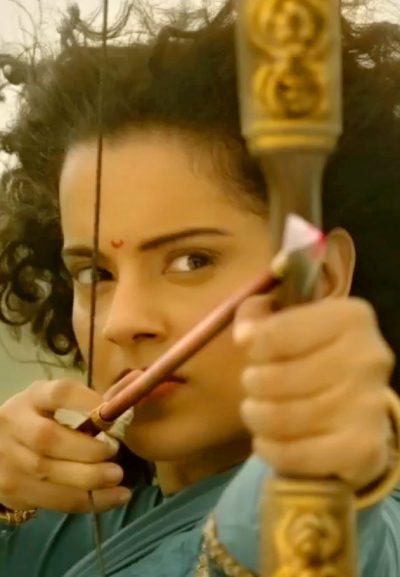★★★½
“Show me the Mani”
 The movie opens with a particularly elaborate disclaimer, admitting that “certain cinematic liberties have been sought,” and that “this film does not claim historical authenticity.” Probably wise: Indians take their national heroes very seriously; just last year, another historical epic, Padmaavat, sparked months of protests, up to and including buses being set on fire. This seems to have largely (but not entirely) escaped such a fate, and likely deservedly. It certainly does little to disrespect the woman, the myth or the legend of Manikarnik, the woman who would become Queen Lakshmibai, and lead a revolt against the British who occupied India in the mid-19th century.
The movie opens with a particularly elaborate disclaimer, admitting that “certain cinematic liberties have been sought,” and that “this film does not claim historical authenticity.” Probably wise: Indians take their national heroes very seriously; just last year, another historical epic, Padmaavat, sparked months of protests, up to and including buses being set on fire. This seems to have largely (but not entirely) escaped such a fate, and likely deservedly. It certainly does little to disrespect the woman, the myth or the legend of Manikarnik, the woman who would become Queen Lakshmibai, and lead a revolt against the British who occupied India in the mid-19th century.
It definitely does adjust things – most notably skipping over the whole “child marriage” thing, which was a key element of Jhansi Ki Rani and The Tiger and the Flame. In this case, Manikarnika (Ranaut) is already fully-grown when she catches the eye of the king of Jhansi, eventually becoming his queen. Thereafter, it goes through her becoming a widow, eviction by the British, rebellion and eventual death in battle, albeit with only a moderate degree of historical accuracy. For, undeniably, there are a fair number of those “certain cinematic liberties,” especially in terms of events being staged and timed for dramatic impact. I’m willing to cut them some slack, since a lot of the results are highly effective.
Curiously, there’s a lot of style adopted from Wonder Woman here, in particular the use of super slow-mo during the action scenes. But it also carries a significant amount of heart: perhaps due to the lead actress also being the co-director? Ranaut knocks it out of the park in some scenes, such as when she’s facing off against villainous British officer Captain Gordon (Edward Sonnenblick, who played a similar role in Jhansi Ki Rani). There are a lot of lines which could come over as cheesy, such as, “This throne doesn’t make me a Queen. It’s the love and faith of Jhansi’s people which does.” But the lead actress delivers them with such conviction, even this Brit was left wanting to stand up and cheer, as a subsequent forced departure from her palace turns into a torch-lit procession of support.
After her bad-ass credentials are established with her shooting a tiger, the first half doesn’t have much action to its name, though is never dull. And this is more than made up for by a rousing second-half filled with impressive battles, though the overall impact is severely hurt by some really poor CGI, such as cannons which fire with zero recoil, and breezes which affect only our heroine, not the grass in which she is supposedly standing. The lack of supporting characters is notable: her husband Gangadhar (Sengupta) was most notable to our eyes, for the Indo-mullet hairstyle he wore. On the British side, Gordon is replaced half-way through by Sir Hugh Rose, to no particular purpose.
However, this is probably the most beautiful film I’ve seen this year; it looks like a Ridley Scott film, and there’s little higher praise than that in my mind. Between that and Ranaut’s intense performance, there’s enough reason to see this, and overcome any problems.
Dir: Kangana Ranaut and Radha Krishna Jagarlamudi
Star: Kangana Ranaut, Atul Kulkarni, Jisshu Sengupta, Vaibhav Tatwawaadi




